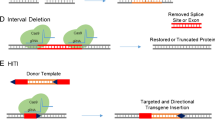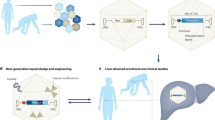Abstract
This article provides an update of liver-directed gene therapy for dyslipidemia, reviewing papers published since 2002 and summarizing progress in gene transfer vectors. Despite the availability of polypharmacy and other therapeutic interventions, the treatment of severe dyslipidemia remains a challenge and continues to be an important target for experimental gene therapy. Gene therapy strategies that focus on long-term therapeutic efficacy of different regimens are emerging from small animal experiments, and new therapeutic genes and/or new approaches have been developed. A novel strategy for gene therapy for diabetes was published recently. Gene therapy for dyslipidemia and diabetes is still in its infancy. Nonetheless, recent progress in this area is encouraging and bodes well for the future.
Similar content being viewed by others
References and Recommended Reading
Pearson TA, Blair SN, Daniels SR, et al.: AHA Guidelines for Primary Prevention of Cardiovascular Disease and Stroke: 2002 Update: Consensus Panel Guide to Comprehensive Risk Reduction for Adult Patients Without Coronary or Other Atherosclerotic Vascular Diseases. American Heart Association Science Advisory and Coordinating Committee. Circulation 2002, 106:388–391.
Grundy SM: Alternative approaches to cholesterol-lowering therapy. Am J Cardiol 2002, 90:1135–1138.
Oka K, Chan L: Recent advances in liver-directed gene therapy for dyslipidemia. Curr Atheroscler Rep 2002, 4:199–207.
Niidome T, Huang L: Gene therapy progress and prospects: nonviral vectors. Gene Ther 2002, 9:1647–1652.
Thomas CE, Ehrhardt A, Kay MA: Progress and problems with the use of viral vectors for gene therapy. Nat Rev Genet 2003, 4:346–358.
Hacein-Bey-Abina S, Von Kalle C, Schmidt M, et al.: LMO2-associated clonal T cell proliferation in two patients after gene therapy for SCID-X1. Science 2003, 302:415–419.
Williams DA, Baum C: Medicine. Gene therapy-new challenges ahead. Science 2003, 302:400–401.
Schroder AR, Shinn P, Chen H, et al.: HIV-1 integration in the human genome favors active genes and local hotspots. Cell 2002, 110:521–529.
Hillgenberg M, Tonnies H, Strauss M: Chromosomal integration pattern of a helper-dependent minimal adenovirus vector with a selectable marker inserted into a 27.4-kilobase genomic stuffer. J Virol 2001, 75:9896–9908.
Harui A, Suzuki S, Kochanek S, Mitani K: Frequency and stability of chromosomal integration of adenovirus vectors. J Virol 1999, 73:6141–6146.
Gaspar HB, Howe S, Thrasher AJ: Gene therapy progress and prospects: gene therapy for severe combined immunodeficiency. Gene Ther 2003, 10:1999–2004.
Gao GP, Alvira MR, Wang L, et al.: Novel adeno-associated viruses from rhesus monkeys as vectors for human gene therapy. Proc Natl Acad Sci U S A 2002, 99:11854–11859.
McCarty DM, Monahan PE, Samulski RJ: Self-complementary recombinant adeno-associated virus (scAAV) vectors promote efficient transduction independently of DNA synthesis. Gene Ther 2001, 8:1248–1254.
Nakai H, Iwaki Y, Kay MA, Couto LB: Isolation of recombinant adeno-associated virus vector-cellular DNA junctions from mouse liver. J Virol 1999, 73:5438–5447.
Duan D, Sharma P, Yang J, et al.: Circular intermediates of recombinant adeno-associated virus have defined structural characteristics responsible for long-term episomal persistence in muscle tissue. J Virol 1998, 72:8568–8577.
Nakai H, Montini E, Fuess S, et al.: AAV serotype 2 vectors preferentially integrate into active genes in mice. Nat Genet 2003, 34:297–302.
Schnell MA, Zhang Y, Tazelaar J, et al.: Activation of innate immunity in nonhuman primates following intraportal administration of adenoviral vectors. Mol Ther 2001, 3:708–722.
Liu Q, Muruve DA: Molecular basis of the inflammatory response to adenovirus vectors. Gene Ther 2003, 10:935–940.
Schiedner G, Hertel S, Johnston M, et al.: Selective depletion or blockade of Kupffer cells leads to enhanced and prolonged hepatic transgene expression using high-capacity adenoviral vectors. Mol Ther 2003, 7:35–43.
Eastman SJ, Baskin KM, Hodges BL, et al.: Development of catheter-based procedures for transducing the isolated rabbit liver with plasmid DNA. Hum Gene Ther 2002, 13:2065–2077.
Sakhuja K, Reddy PS, Ganesh S, et al.: Optimization of the generation and propagation of gutless adenoviral vectors. Hum Gene Ther 2003, 14:243–254.
Palmer D, Ng P: Improved system for helper-dependent adenoviral vector production. Mol Ther 2003, 8:846–852.
Belalcazar LM, Merched A, Carr B, et al.: Long-term stable expression of human apolipoprotein A-I mediated by helper-dependent adenovirus gene transfer inhibits atherosclerosis progression and remodels atherosclerotic plaques in a mouse model of familial hypercholesterolemia. Circulation 2003, 107:2726–2732.
Libby P: Inflammation in atherosclerosis. Nature 2002, 420:868–874.
Hopkins PN: Familial hypercholesterolemia-improving treatment and meeting guidelines. Int J Cardiol 2003, 89:13–23.
Lebherz C, Gao G, Louboutin J, et al.: AAV2/7 and AAV2/8 mediated liver directed gene therapy enables long-term expression of the human LDL receptor and substantially diminishes atherosclerosis in LDL receptor deficient mice. Circulation 2003, 108:IV-143.
Chen SJ, Rader DJ, Tazelaar J, et al.: Prolonged correction of hyperlipidemia in mice with familial hypercholesterolemia using an adeno-associated viral vector expressing very-low-density lipoprotein receptor. Mol Ther 2000, 2:256–261.
Oka K, Nomura S, Merched A, et al.: In-vivo LDL receptor gene therapy is highly effective in reversing hypercholesterolemia in a mouse model of familial hypercholesterolemia. Mol Ther 2003, 7:S246.
Liu G, Ashbourne Excoffon KJ, Wilson JE, et al.: Phenotypic correction of feline lipoprotein lipase deficiency by adeno-viral gene transfer. Hum Gene Ther 2000, 11:21–32.
Ross C, Meulenberg J, Twisk J, et al.: Long-term correction of murine lipoprotein lipase deficiency by single intramuscular administration of AAV1-LPLS447X. Mol Ther 2003, 7:S22.
Rip J, Nierman M, Sierts J, et al.: Working towards clinical application of gene therapy for LPL deficiency. Circulation 2003, 108:IV-133.
Zsigmond E, Kobayashi K, Tzung KW, et al.: Adenovirus-mediated gene transfer of human lipoprotein lipase ameliorates the hyperlipidemias associated with apolipoprotein E and LDL receptor deficiencies in mice. Hum Gene Ther 1997, 8:1921–1933.
Heistad DD: Unstable coronary-artery plaques. N Engl J Med 2003, 349:2285–2287.
Naghavi M, Libby P, Falk E, et al.: From vulnerable plaque to vulnerable patient: a call for new definitions and risk assessment strategies: Part I. Circulation 2003, 108:1664–1672.
Rust S, Rosier M, Funke H, et al.: Tangier disease is caused by mutations in the gene encoding ATP-binding cassette transporter 1. Nat Genet 1999, 22:352–355.
Remaley AT, Rust S, Rosier M, et al.: Human ATP-binding cassette transporter 1 (ABC1): genomic organization and identification of the genetic defect in the original Tangier disease kindred. Proc Natl Acad Sci U S A 1999, 96:12685–12690.
Joyce CW, Amar MJ, Lambert G, et al.: The ATP binding cassette transporter A1 (ABCA1) modulates the development of aortic atherosclerosis in C57BL/6 and apoE-knockout mice. Proc Natl Acad Sci U S A 2002, 99:407–412.
Singaraja RR, Fievet C, Castro G, et al.: Increased ABCA1 activity protects against atherosclerosis. J Clin Invest 2002, 110:35–42.
Su YR, Ishiguro H, Major AS, et al.: Macrophage apolipoprotein A-I expression protects against atherosclerosis in ApoE-deficient mice and up-regulates ABC transporters. Mol Ther 2003, 8:576–583.
Basso F, Freeman L, Knapper CL, et al.: Role of the hepatic ABCA1 transporter in modulating intrahepatic cholesterol and plasma HDL cholesterol concentrations. J Lipid Res 2003, 44:296–302.
Wellington CL, Brunham LR, Zhou S, et al.: Alterations of plasma lipids in mice via adenoviral-mediated hepatic over-expression of human ABCA1. J Lipid Res 2003, 44:1470–1480.
Mertens A, Verhamme P, Bielicki JK, et al.: Increased low-density lipoprotein oxidation and impaired high-density lipoprotein antioxidant defense are associated with increased macrophage homing and atherosclerosis in dyslipidemic obese mice: LCAT gene transfer decreases atherosclerosis. Circulation 2003, 107:1640–1646.
Jaye M, Lynch KJ, Krawiec J, et al.: A novel endothelial-derived lipase that modulates HDL metabolism. Nat Genet 1999, 21:424–428.
Ma K, Cilingiroglu M, Otvos JD, et al.: Endothelial lipase is a major genetic determinant for high-density lipoprotein concentration, structure, and metabolism. Proc Natl Acad Sci U S A 2003, 100:2748–2753.
Ishida T, Choi S, Kundu RK, et al.: Endothelial lipase is a major determinant of HDL level. J Clin Invest 2003, 111:347–355.
Maugeais C, Tietge UJ, Broedl UC, et al.: Dose-dependent acceleration of high-density lipoprotein catabolism by endothelial lipase. Circulation 2003, 108:2121–2126.
Broedl UC, Maugeais C, Marchadier D, et al.: Effects of non-lipolytic ligand function of endothelial lipase on high density lipoprotein metabolism in vivo. J Biol Chem 2003, 278:40688–40693.
Kawashiri M, Zhang Y, Usher D, et al.: Effects of coexpression of the LDL receptor and apoE on cholesterol metabolism and atherosclerosis in LDL receptor-deficient mice. J Lipid Res 2001, 42:943–950.
Kawashiri MA, Zhang Y, Pure E, Rader DJ: Combined effects of cholesterol reduction and apolipoprotein A-I expression on atherosclerosis in LDL receptor deficient mice. Atherosclerosis 2002, 165:15–22.
Jalkanen J, Leppanen P, Pajusola K, et al.: Adeno-associated virus-mediated gene transfer of a secreted decoy human macrophage scavenger receptor reduces atherosclerotic lesion formation in LDL receptor knockout mice. Mol Ther 2003, 8:903–910.
Ouchi N, Kihara S, Funahashi T, et al.: Obesity, adiponectin and vascular inflammatory disease. Curr Opin Lipidol 2003, 14:561–566.
Okamoto Y, Kihara S, Ouchi N, et al.: Adiponectin reduces atherosclerosis in apolipoprotein E-deficient mice. Circulation 2002, 106:2767–2770.
Chan L, Fujimiya M, Kojima H: In vivo gene therapy for diabetes mellitus. Trends Mol Med 2003, 9:430–435.
Kojima H, Fujimiya M, Matsumura K, et al.: NeuroD-betacellulin gene therapy induces islet neogenesis in the liver and reverses diabetes in mice. Nat Med 2003, 9:596–603.
Author information
Authors and Affiliations
Rights and permissions
About this article
Cite this article
Oka, K., Chan, L. Liver-directed gene therapy for dyslipidemia and diabetes. Curr Atheroscler Rep 6, 203–209 (2004). https://doi.org/10.1007/s11883-004-0033-6
Issue Date:
DOI: https://doi.org/10.1007/s11883-004-0033-6




